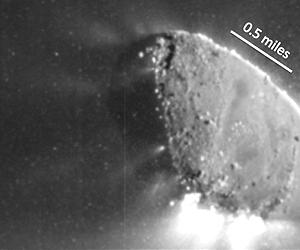
This enhanced image, one of the closest taken of comet Hartley 2 by NASA's EPOXI mission, shows jets and where they originate from the surface.
There are jets outgassing from the sunward side, the night side, and along the terminator - the line between the two sides.
The image was taken by EPOXI's Medium-Resolution Instrument on Nov. 4, 2010. The sun is to the right. Credit: NASA/JPL-Caltech/UMD
Analysis of the spectral signatures of the materials coming from the jets shows primarily CO2 gas (carbon dioxide) and particles of dust and ice.
"Previously it was thought that water vapour from water ice was the propulsive force behind jets of material coming off of the body, or nucleus, of comet," said University of Maryland astronomy professor Jessica Sunshine, who is deputy principal investigator for the EPOXI mission.
"We now have unambiguous evidence that solar heating of subsurface frozen carbon dioxide (dry ice), directly to a gas, a process known as sublimation, is powering the many jets of material coming from the comet.
This is a finding that only could have been made by traveling to a comet, because ground based telescopes can't detect CO2 and current space telescopes aren't tuned to look for this gas," Sunshine said.
Sunshine and other members of the EPOXI science team are meeting all this week at the University of Maryland to analyse the very large amount of data from the closest approach, and new data continues to come down at a rate of some 2,000 images a day.






No comments:
Post a Comment